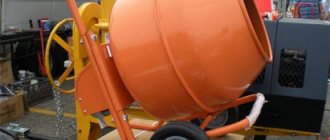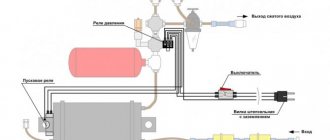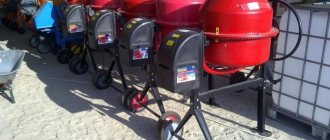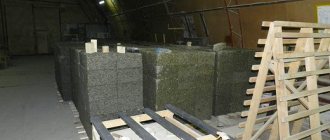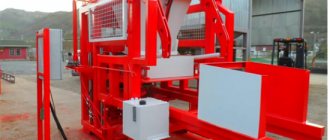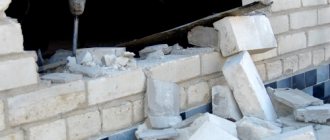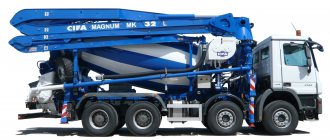Beton-House.com
Website about concrete: construction, characteristics, design. We combine the experience of professionals and private craftsmen in one place
Concrete mixer device
Modern designs for preparing concrete mixtures are reliable devices that, when used correctly, will last for many years. When building a house, a concrete mixer is simply irreplaceable - how to use it correctly?
Unit breakdowns that may occur over time can be eliminated quite easily, even by people who do not have great skills in carrying out repair work. The article suggests getting acquainted with the types and features of structures, adjusting components for proper operation of the unit, and will tell you how to disassemble a concrete mixer and eliminate some of its malfunctions.
Types of designs
Companies produce a variety of models of concrete mixers, which makes it difficult for an unprepared person to immediately decide and choose a specific unit.
Brief information about what they are and what their features are is presented in the table:
| Device type | Peculiarities |
| According to the operating principle | |
| The operating principle of the design is based on the rotation of the drum at high speed. Inside it there are fixed blades that lift the solution up, and then it falls down under its own weight, mixing at the same time. The blades prevent the mixture from sliding off the drum walls, which allows you to obtain good quality concrete. |
| The main difference between such units is the stationary container. In this case, the solution is mixed with special blades, which are driven by a powerful engine. The solution in such devices for mixing concrete is of the highest quality. Typically, such structures have a large volume and are used on large construction sites. |
| By device type | |
| In a gravity type concrete mixer, the drum rotates thanks to a gear mechanism. Rotation on the gear wheel (ring) is transmitted by a drive rigidly mounted on its outer diameter. Due to the lack of protection of the crown from dust, abrasive particles, and dirt, it begins to quickly wear out and fail. |
| The operational reliability and durability of gravity gear mixers for concrete are significantly higher than crown mixers. In this case, the gearbox is well protected from debris, sand, and water getting into it. However, if the gear mixer drive breaks down, it is very difficult, almost impossible, to restore normal operation of the unit. |
| By volume | |
| From 50 to 150 liters | Such small units have manual unloading of concrete in the form of a steering wheel. They are convenient to use for the construction of one- and two-story houses. Typically these are mobile, easily movable structures. |
| In such devices, the entire process occurs automatically, which greatly facilitates the work of the builder. But the price of the units is quite high. |
In addition, the designs of the units are:
- Electrical.
- Mechanical.
- Cyclic action.
- Continuous action.
Regardless of the type, all concrete mixers are manufactured based on the same principle.
They consist of the main components:
- Reservoir for mixing the solution.
- Mixing mechanism that mixes the mixture.
- Support.
When working:
- Cement, sand and water are poured into the tank.
- The blades are turned on for 5 - 15 minutes.
- The drive switches off.
- The device turns over.
- The finished solution is poured into the prepared container.
Pouring the solution
Advantages and disadvantages
Advantages:
- The manual mortar mixer is completely autonomous.
- A motor-driven concrete mixer also has a high degree of autonomy and only requires fuel.
- The crown is quite simple to repair and operate.
Flaws:
- The disadvantages of concrete mixers include their seasonality. Most, especially small concrete mixers, are unsuitable for use during periods of sub-zero temperatures . This makes it necessary to adapt a steam generator to work with them in winter.
- There are more expensive concrete mixers that can work in any season, which initially have a steam generator unit built into them.
- A conventional mortar mixer, designed to operate only at positive temperatures (at least 2°C), is not equipped with devices that provide heating of the mixture.
- The disadvantages of a manual mortar mixer are low productivity and high labor intensity of mixing.
- The disadvantages of motor-driven concrete mixers are: high cost of fuel, toxicity of exhaust gases and high noise level when the engine is running.
- The disadvantage of electric concrete mixers is that when the power is turned off, after a certain period of time, the hatch opens and the mixture is discharged to prevent it from hardening. In addition, ring gears require frequent removal and cleaning or repair of the ring, while gearboxes require replacement of the entire gearbox if they break down.
Main components of a concrete mixer
How to draw a device for mixing concrete
The figure shows the main components of the unit.
These include:
- Drum.
- Frame.
- Remote Control.
- Engine.
- Mechanism for moving working parts.
- Tipping mechanism.
After familiarizing yourself with the question of what types of concrete mixers there are and their main components, you can choose the right option for yourself.
How to make a concrete mixer with your own hands, a step-by-step guide with diagrams and drawings
The diagram below clearly shows how to make a concrete mixer using an ordinary can. This device is not suitable for large construction works, but it is effective when mixing small volumes of concrete and mortar.
The neck provides the necessary tightness; ingredients are poured through it and the finished mixture is poured. The base is made from a channel (angle). The couplings are secured to the stops. The holes for the rotary shaft are drilled on the same line.
Criterias of choice
Varieties
When choosing a unit for mixing concrete, you should determine for what purpose it is needed and how often the device will be used? The characteristics of the suitable option depend on this.
In this case, it is necessary to pay attention to such indicators as:
- Bucket volume. Usually this characteristic is indicated in the passport.
Tip: It should be borne in mind that the volume of concrete in the barrel is only 2/3 of its declared capacity.
- What is the speed of the concrete mixer?
- The material used to make the drum. Modern models have a steel body. The only difference is the thickness.
Tip: When purchasing a device, you must take into account that concrete can corrode metal. For long-term operation of the unit, preference should be given to options with a steel thickness of more than 1-2 mm.
- Unit operating mode. It requires a power source with a voltage of 220 V. With a drum volume of 0.5-1 m³, a more powerful motor is used, powered by a 380 V network.
- Engine protection degree. The mechanism must be located in a special casing.
Using a concrete mixer
When buying or renting a concrete mixer, you need to consider the following factors:
Drum capacity volume
- for private construction, a mortar mixer with a volume of 100 to 300 liters is sufficient;
- Professional construction requires devices with working capacities of more than 300 liters.
Other criteria:
- Power . For private construction, a power of 700-800 W is sufficient.
- Voltage . Non-professional models operate at a voltage of 220 V.
- Class . There is no professional level required for custom construction . Such equipment is much cheaper.
- Seasonality . If there is no urgent need to build in winter, then a conventional unit is sufficient to operate at positive temperatures. It is cheaper and at positive temperatures high quality concrete .
- Strength of working capacity . You should choose containers made on rollers. They have a worse appearance than elongated ones, but are made of thicker steel, are strong and durable.
- Overload sensor . It is desirable to have a device for automatically shutting off the concrete mixer when the temperature in the motor winding rises excessively.
- Material . The most reliable are units with a cast iron crown.
- Loading-unloading . The presence of such a system ensures convenience and efficiency in the preparation of the mixture.
When working with a concrete mixer, you must follow the standard procedure:
- it is necessary to check the serviceability of the unit externally;
- then a test run is performed with an empty working container (either drum or shaft);
- the unit is stopped and prepared for operational start-up;
- the working container is filled with water, cement, sand, filler and additives;
- After complete mixing, the unit is emptied of the solution by draining through the hatch or turning the drum over.
Assembling a concrete mixer
After purchasing the unit, the question is how to assemble it?
Concrete mixer kit
The assembly order is as follows:
- The box is opened.
- The completeness is checked according to the instructions. It includes:
- Frame.
- Top of the drum.
- Set of legs.
- Drive box.
- Tipper.
- Blades.
- To move the wheel device.
- Set of mounting bolts.
- The legs are installed so that the wheels are on the side of the drive box.
- The wheels are mounted on the axle and secured with plastic plugs.
Wheel installation
Drum assembly
Regardless of the design of concrete mixers, they all have a drum where the solution will be mixed.
To build it:
- The upper part is removed from the lower part.
- Along the perimeter of the lower part of the container, install a gear ring with your own hands and secure it with four bolts.
- The upper part fits onto the lower one. Before this, the previously installed bolts are removed. The fasteners must be removed very carefully so that the ring gear does not warp or move.
- The ring gear is lowered onto the U-shaped part that holds the drum.
- The upper part of the container is installed on the lower part.
- The ring gear is finally attached.
- The blades are inserted.
How to install the blades correctly
Adjusting the gap between the ring and gear
To increase the service life of the unit, it is necessary to select the correct gear gap. How to adjust the gear?
Gear and gear engagement
For this:
- Use a feeler gauge to check the gap between the teeth of two parts.
- The crown on the drum is located rigidly. This means that it cannot be moved.
- The drive gear can be moved in or out using washers and spacers. If there are grooves for displacing the gear mounting unit, the bolts are loosened and the required gap between the teeth is selected - its value is indicated in the instructions for using the unit. Typically it is 0.1 - 0.3 mm for new installations, and up to 0.55 mm for worn ones.
Working of a concrete mixer
Exploitation
Before mixing the solution in a concrete mixer, you must run the unit at idle speed.
For this:
- The product is installed on a hard surface. In this case, its slope should not exceed 5°.
- Connects to a grounding electrical outlet on the equipment power supply cord.
- The concrete mixer turns on and runs for approximately 30 seconds.
- Its performance is checked for the presence of extraneous noise, increased vibration and other defects.
Advice: If you detect deviations in the operation of the unit from the specified characteristics, you should contact the service center. Here, if necessary, they will tell you how to use the concrete mixer correctly.
Manufacturers
There are European manufacturers, there are Russian ones, and there are our brands that order concrete mixers from China.
The first two options will be more reliable. Of these, we will highlight the Eastern European companies Limex and Zitrek, and from the Russian concrete mixers from the cities of Lebedyan (Lipetsk region) and Beloretsk (Bashkiria). The first ones are produced either under the name Lebedyan or Denzel. The latter are best known under the brands Profmash, Entuziast, and Teplotrade. But they are also produced under other less well-known names - the main thing is that they are assembled in Beloretsk.
Chinese concrete mixers are available, for example, under the brands Prorab, Elitech, Wert, Kraton and many others. Not to say that they work poorly, but, firstly, their build quality is poor (the holes may simply not match during assembly), and secondly, if they break down, it can be difficult to find spare parts.
Preparation of concrete mixture
After the device has been assembled, the owner has familiarized himself in detail with how to use it and checked the unit for functionality, it is necessary to prepare the mixture in a certain proportion.
For example:
- To prepare one cubic meter of concrete, 125 liters of water are required. Do not allow excess liquid. This may lead to a decrease in the strength of the solution.
- Sand with a grain size of up to 5 mm is required. Its amount should be 30-45% by weight of the finished solution.
- Gravel takes up 55-70%.
- The ratio of sand and gravel is 1:1.2. When using crushed stone instead of gravel, the ratio should be: 1:2.
Approximate ratio of materials in a concrete mixture
High-quality concrete can only be obtained using clean sand and water, without contamination with oils or any aggressive substances. In summer the water is used cold, and in winter it is heated to 40°C. The concrete mixer is ready for operation - what it looks like before turning it on is shown in the photo.
Preparing the unit for switching on
To better imagine how to use a concrete mixer, the video lesson will tell you in detail. After finishing the work, the question is how to clean the concrete mixer?
Wherein:
- The internal and external surfaces of the unit are washed.
- The drum is washed with crushed stone and water.
- Solvents must not be used.
- Do not allow water to come into contact with the engine.
- The tightness of all fasteners should be checked periodically.
- The engine ventilation openings should always be kept clean.
The video in this article shows in detail how to properly assemble a concrete mixer or disassemble it after use.
A little about the rules of operation
- When working, the concrete mixer must stand steadily, preferably on a flat surface.
- Components should only be loaded into a rotating drum.
- The kneading lasts approximately 2-3 minutes. After this, the rotation should be stopped and unloaded from the non-rotating drum. Otherwise, the support bearing may quickly wear out.
- After work, you should rinse the concrete mixer with water so that the frozen solution does not cause you trouble during the next work.
These are the features of choosing and operating a concrete mixer. Happy shopping and happy work!
Video “How to choose a concrete mixer.”
Mechanical mixers
A homemade mechanical concrete mixer with your own hands is very similar in appearance to a gravitational one. The main difference is inside her.
These are guide and cutting blades welded to the inner walls of the container. They direct the fall of the overturned layers, cutting them into separate parts.
In this case, the dough will be of higher quality and in a shorter time. The presence of blades changes the very principle of gravitational mixing. Therefore, the working container can be positioned not only horizontally, but also at an angle, which allows for more efficient use of the volume of the concrete mixer and makes work more convenient.
In addition, a working container installed at an angle to the horizontal no longer requires a sealed lid, and the finished mixture can be dumped through a constantly open hole by turning the working container itself over.
Making a working container
You can also use a steel barrel as a working container, to the inner walls of which steel blades should be welded at an angle of 30-35 degrees. The height of the blades should be equal to a quarter of the diameter of the barrel. It is possible to weld the blades to a rotating shaft running inside.
A more difficult option would be to make a container of your own design, a kind of homemade product. To do this, you will need a piece of thin-walled steel pipe with a wall thickness of 2.5-3.5 mm, a diameter of at least 800 mm and a length of at least a meter.
The supporting frame is best made from steel profile pipes.
One side of the pipe is welded with a steel circle. On the other side, 4-6 triangular segments are cut out, which are folded to the middle and welded together. The result is a container resembling a pear. The blades are welded inside the pear, and in the center, on the outer side of the bottom, a steel axle is welded for subsequent fastening of the drive pulley.
They are less susceptible to bending than angle bars and are relatively lightweight. The frame design should include the installation of support wheels on which the container will rest, and a platform for installing the electric motor.
The frame itself should consist of two parts:
- the support on which the entire structure will be supported;
- rotating, on which the working container will rest.
Support frame with handle and wheels.
The supporting and rotating parts of the frame are connected to each other through short shafts mounted in bearings or bushings.
A transverse handle must be welded to one of the shafts to allow tilting of the rotating part of the frame, and with it the working container, which will lie on the frame, resting on wheels.
Mechanical concrete mixer drive
The drive for rotating the mixer in devices of this type is extremely rare and only with a small volume of working capacity. Typically, an electric motor connected to the mixer through a belt drive is used for rotation.
It is even better to connect the electric drive through a gearbox, but a self-made concrete mixer in this case will be too expensive in terms of the necessary components. In factory designs, you can see a gear drive from a motor installed on the side of the tank, at the location of the largest diameter, but with self-manufacturing, such a solution is only theoretically feasible.
The lineup
The model line includes variations of vehicles that use various models of KamAZ trucks as a basis. This point largely determines the operational potential of the vehicle.
KamAZ 581453
The three-axle concrete mixer has a 6x4 wheel arrangement. The truck is equipped with a hydromechanical drive and a reliable power plant made in Germany. The planetary gearbox was manufactured in Italy. The main functional elements subject to the greatest wear are made using high-strength steel. This moment ensures the overall maximum service life of the machine. The model is designed for use throughout the year. This becomes possible due to the fact that the chassis engine heats the liquid in the water tank with exhaust gases.
Technical characteristics of the KamAZ 581453 concrete mixer:
| Characteristics | Indicators |
| Total weight, kg | 27500 |
| Load capacity, kg | 18900 |
| Basic chassis | KamAZ 6520 |
| Dimensions, mm: | |
| - length | 8600 |
| - height | 2500 |
| - width | 3800 |
| Water tank capacity, l | 450 |
| Mixing drum volume, m3 | 14 |
| Drum loading height, mm | 3800 |
| Unloading height, mm | 2200-500 |
| Mixing duration, min | 20 |
| Engine power, hp | 320 |
| Engine power, kW | 235 |
Photo of concrete mixer truck KamAZ-581453
KamAZ 58147s
This model is designed for operation in temperatures from -20 to +40 degrees. The concrete mixing plant is capable of functioning completely autonomously. This becomes possible thanks to the presence of an individual power plant and tank. The high pressure fuel pump is controlled using a flexible cable.
Technical characteristics of the KamAZ 58147s model:
| Characteristics | Indicators |
| Total weight, kg | 24000 |
| Basic chassis | KamAZ 53229 r |
| Dimensions, mm: | |
| - length | 9000 |
| - height | 2500 |
| - width | 3700 |
| Water tank capacity, l | 450 |
| Mixing drum volume, m3 | 12 |
| Drum loading height, mm | 3700 |
| Unloading height, mm | 2200-500 |
| Engine power, hp | 330 |
| Engine power, kW | 240 |
Photo of concrete mixer truck KamAZ-58147s
KamAZ-58145z
Such concrete mixer trucks are characterized by high productivity. The model is built on the KamAZ 65115 62 chassis. With a total weight of 27.5 tons, the maximum load capacity of the vehicle remains at 17 tons. A 300-horsepower unit capable of producing 225 kW is used as a power plant.
We determine the volume of the pear based on the volume of construction
Household concrete mixers are not massive, they can be moved manually (by two people), while large-sized ones are highly productive, for large construction sites and powerful output.
65-100 l: standard for a small construction site, it can be transported in a car trailer. The advantage is mobility, the disadvantage is low productivity. Suitable for building the foundation of a small building, a gazebo, or a foundation for fencing an area. Experts call such mechanisms “seasonal”.
“Concrete containers” with a volume of 120-180 liters are suitable for independent work. If you plan to tackle a small construction site without help, such a concrete mixer will definitely be the solution to the problem. The result of her work is 80-100 liters of ready-made solution in one go.
When a team is working and a serious object has to be removed in a short time, powerful, productive equipment will be required - with a mixer of 200 liters or more.
A concrete mixer with a volume of more than 300 liters is a professional unit, designed for a team and daily work for at least 12 hours. Suitable for large-scale construction.
